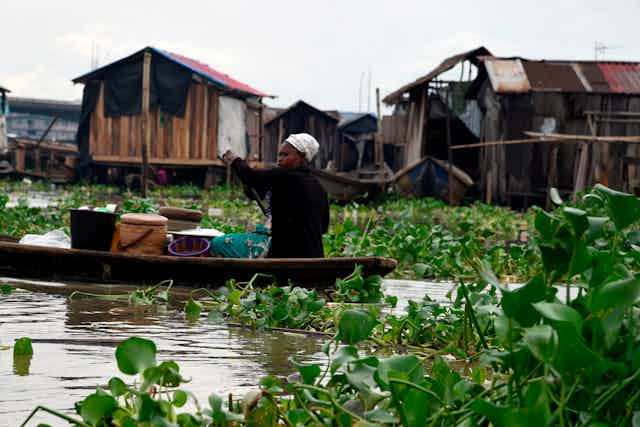Lagos is a city of two halves: money dripping in the corridors of corporate offices, and stagnant water dripping in the slums that are home to over 20 million. Residents of informal settlements grapple with the daily challenges that come with inadequate infrastructure, limited access to essential services, and social exclusion.
Social exclusion means being excluded from participating wholly in the society, often as a result of belonging to a minority group or residing in less advantaged areas or regions.
Slums in the context of Lagos refer to informal settlements, often overcrowded, without basic amenities, and characterised by poor living and environmental standards. They are largely occupied by people who cannot afford housing and are primarily informal sector workers. Over 200 slum communities have been identified in Lagos State.
Lagos is also the biggest contributor to the country’s gross domestic product (GDP). It accounts for 26.7% of Nigeria’s total GDP and more than 50% of non-oil GDP.
Lagos, with its thriving economy and status as a commercial hub, attracts people from other parts of Nigeria in pursuit of opportunities. The state currently has a population of over 25 million people.
This influx has not brought prosperity for all. Beneath the promises of economic growth, there’s a stark and often overlooked reality.
My research has looked into the vulnerabilities of slum dwellers and how they can be socially included to improve their socioeconomic well-being. Slum dwellers face multifaceted deprivations and tackling these challenges requires a multifaceted approach.
Social inclusion would empower slum dwellers to participate actively in decision-making processes that affect their lives. It would give them a voice and a platform to advocate for their rights and interests, leading to more inclusive and equitable policies and practices.
Three areas of social inclusion
In my recent study, I showed how slum dwellers could enjoy social inclusion using three approaches: social relations, political participation, and labour market inclusion.
My study made use of primary data from three coastal slums which have been identified as some of the largest slums in Lagos State.
A structured questionnaire was used to elicit 400 responses and 388 of these were analysed further. The questions related to three broad areas: social relations, government and the labour market.
What social support or relationships exist?
Social support is an important aspect of community living. Relationships within the community foster a sense of belonging and identity. Social networks offer help in times of need. But the urban way of life does not encourage this as much as rural life does, and there is an expectation that people living in Lagos State are wealthy.
My study revealed a wide gap in social support between some of the slum inhabitants and their relatives in other parts of and outside Nigeria.
Even when these slum residents needed financial, material and other forms of social support, they were afraid to reach out to their families in the villages. For fear of being disbelieved or made fun of, they would rather manage on their own.
Another form of social support came from non-governmental organisations. NGOs had become a major source of support for slum dwellers. But people in the study often already had what the NGOs offered. For example, a respondent said they already had clothes and would be grateful if they were empowered with tools instead so that they could earn a living.
Read more: Lagos city planning has a history of excluding residents: it's happening again
How beneficial is governance?
Effective governance and active political engagement are key indicators of social inclusion. These are particularly relevant for slum dwellers to ensure social justice and community development. However, in the area of political participation, my study found that there was a high level of distrust in the government among the slum dwellers. One respondent said politicians had used them for political advantage.
During campaigns, many politicians promise projects for their communities but end up disappointing them or even threaten them with forced eviction. Many of the respondents claimed they only participated in political activities because it was their right to do so, but they did not reap much benefit from it. Some said they didn’t believe their opinions counted in such programmes.
What is their involvement in the labour market?
The labour market offers people opportunities to generate income, contributing to their financial stability and well-being. It also offers opportunities to develop skills and build capacity. Most slum dwellers work in the informal sector. My study found that many were involved in fishing, petty trading and artisanry. Despite earning a meagre income ranging from N30,000 to N60,000 (about US$20-$40 per month), many expressed satisfaction with their current occupations because they lacked alternatives.
Many were willing to attend training to enhance their productivity.
Integration of slum residents
I propose that to integrate slum residents more fully, the following measures should be taken:
regular awareness campaigns emphasising that people don’t have it all simply because they live in the city
NGOs should understand what people expect and need from projects, to avoid redundant interventions
advocacy for slum upgrades, interventions and consistent engagement by those in governance.
It is crucial to direct both social support and political inclusion towards empowering these communities. The provision of tools that can augment their productivity and boost income is a key component of this empowerment strategy.

